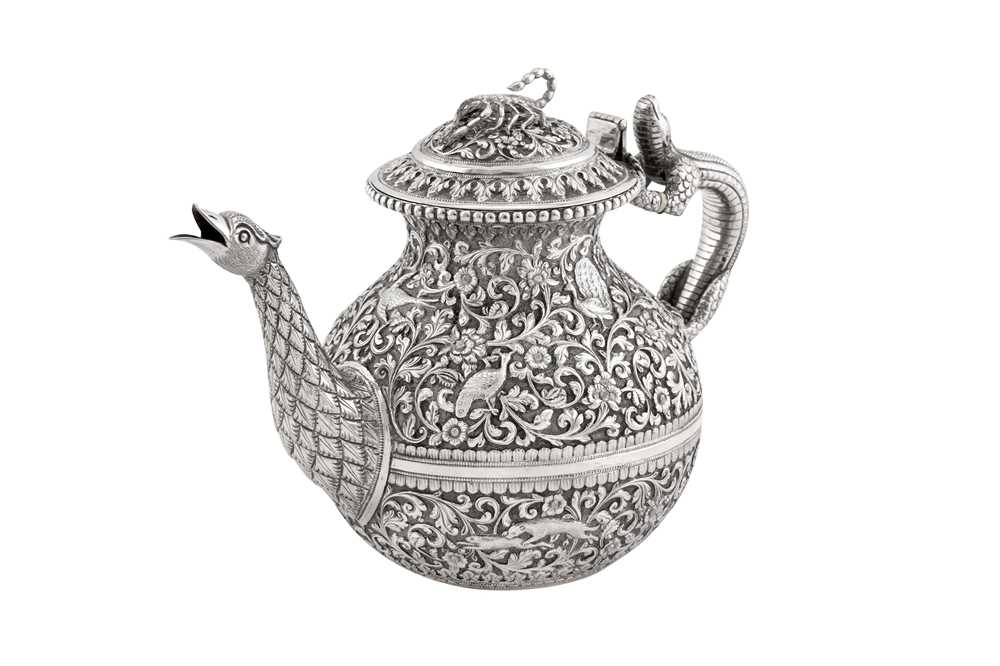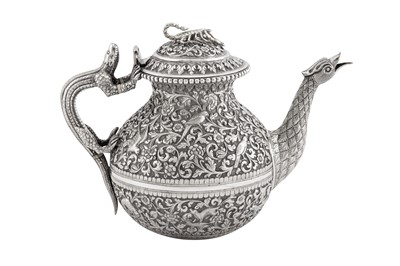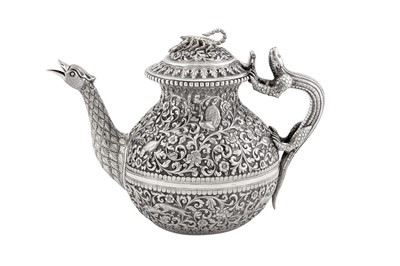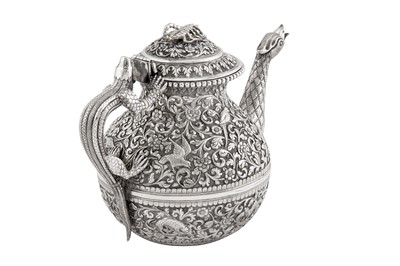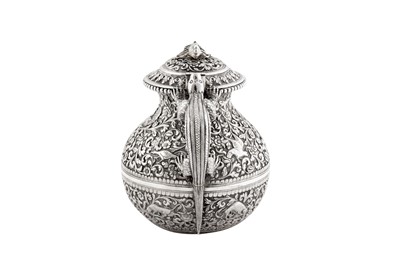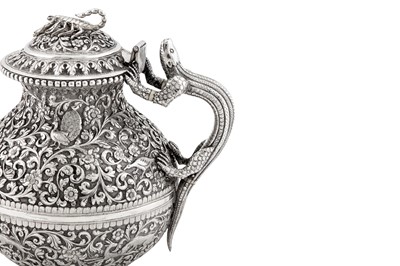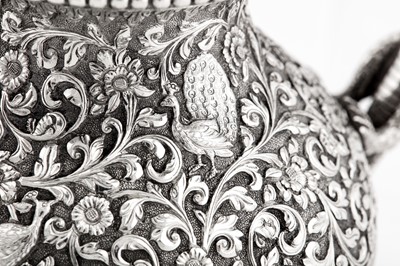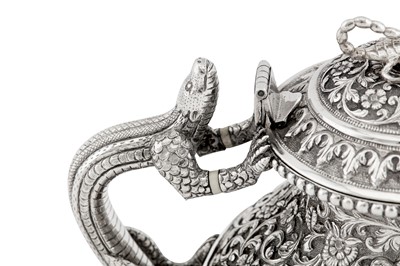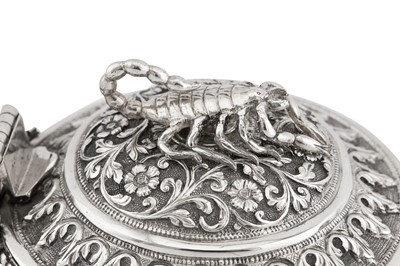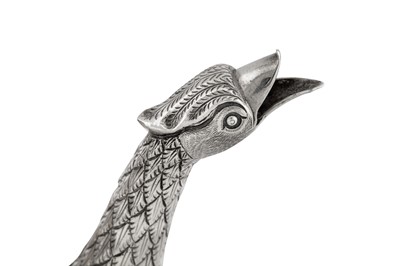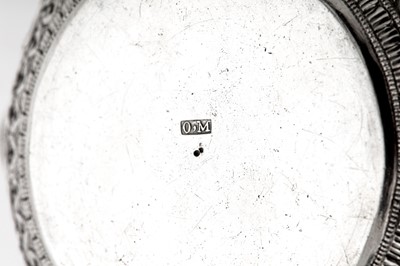14th Feb, 2023 10:00
The Stewart Collection of Indian and Burmese Silver
A fine late 19th century Anglo – Indian silver teapot, Cutch, Bhuj circa 1880 by Oomersi Mawji (active 1860-90)
A fine late 19th century Anglo – Indian silver teapot, Cutch, Bhuj circa 1880 by Oomersi Mawji (active 1860-90)
Raj period. Of baluster form modelled after a lota, the everted neck with beaded edge. The curved spout terminating in a Black Francolin birds head, chased with feathers, opposite a handle formed as a lizard, with inset ivory insulators in the tail and upper limbs, carved to follow the scales of the lizard. The hinged domed lid surmounted by a detachable finial formed as a scorpion. The body with a plain central girdle between textured bands, otherwise with finely deep chased decoration of foliate scrolls and rosettes populated with birds including peacocks to the upper section and hunting animals to the lower section, a fox after a hare and a wild dog attacking an antelope. The lid similarly chased with foliate scrolls. Marked underneath with maker’s mark only O,M.
Length – 20.5 cm / 8.05 inches
Weight – 598 grams / 19.23 ozt
Oomersi Mawji – Master Silversmith
Of all the Indian silver producing artisans in India, one name stands out as associated with pieces of the very finest quality: Oomersi Mawji. Pieces by this accomplished master began to appear circa 1860 and they continued to be produced by his sons and grandsons will into the twentieth century.
There is no doubt that Oomersi Mawji was one of the most gifted silversmiths working anywhere in the world during his lifetime. His understanding of form, proportion and decoration, his willingness to devote extra labour to a piece to truly perfect it to world-class standards, and his use of an extremely high grade of silver (often 98 per cent pure) combine to lend even the most mundane objects an aura of grandeur, placing this artist in the ranks of the finest craftsmen. The standards of quality, workmanship, and design, often enhanced with a little humour (the lizard about to pounch on the scorpian in this case) were passed to the artist’s progeny and characterise their work as well.
With its sensuous forms and intricate ornament, the work of Oomersi Mawji has enormous appeal. Every painstaking detail covering almost the whole surface of each object is an element drawn from nature. Sinuous plants coil and wind in infinite undulating, swirling patterns through which emerge stylised poppies, which curl and twist to reveal every stage of flowering.
The laborious process of chasing the silver to this design from the outside while the interior is filled with mixture of resin and wax called kil, it involves heating the metal and cooling it rapidly to soften it then repeating the chasing with kil once or twice again. This process has often wrongly been referred to as repoussé. "Working the silver with ingenious skill and patience, Oomersi Mawji and his sons raised the quality of decoration on Cutch silver to an art form" notes Wynyard Wilkinson in his seminal Indian Silver 1858 - 1947: Silver from the Indian Sub-continent and Burma Made by Local Craftsmen in Western Forms [London, 1999].
The use of the Black Francolin bird is a recurring motif with the workshop of Mawji, often forming the terminal of a spout, or as in the case of perhaps his most iconic design, the whole bird itself forming the vessel, an example of a complete tea set of which was sold Christie’s London, 12 June 2004, lot 234 (£27,500 incl. prem).
A milk jug with a Black Francolin bird head spout by Mawji jnr was sold Bonham’s Knightsbridge, 28 July 2021, lot 230 (£2,167.50 incl. prem)
A very close design for this teapot has survived as part of the Elizabeth and John Sequeira collection, illustrated Dehejia, V. (2008), Delight in Design Indian Silver for the Raj, Ahmedabad: Mapin Publishing. P. 39, fig. 3. Available as a 1 pint, ¾ pint and ½ pint capacity. Additionally, an almost identical design for this teapot, including the central band diving the two registers of decoration as birds above and animals below has survived as part of a corpus of drawings by Raghavji Mawji, a contemporary of Oomersi Mawji, sold Bonham’s New Bond Street, 22 Oct 2019, lot 166. This teapot is known from other surviving examples to have been available with a similarly formed sugar bowl and milk jug.
Ivory Declaration: ZAY9QTT2
Sold for £9,375
Includes Buyer's Premium
Do you have an item similar to the item above? If so please click the link below to submit a free online valuation request through our website.
